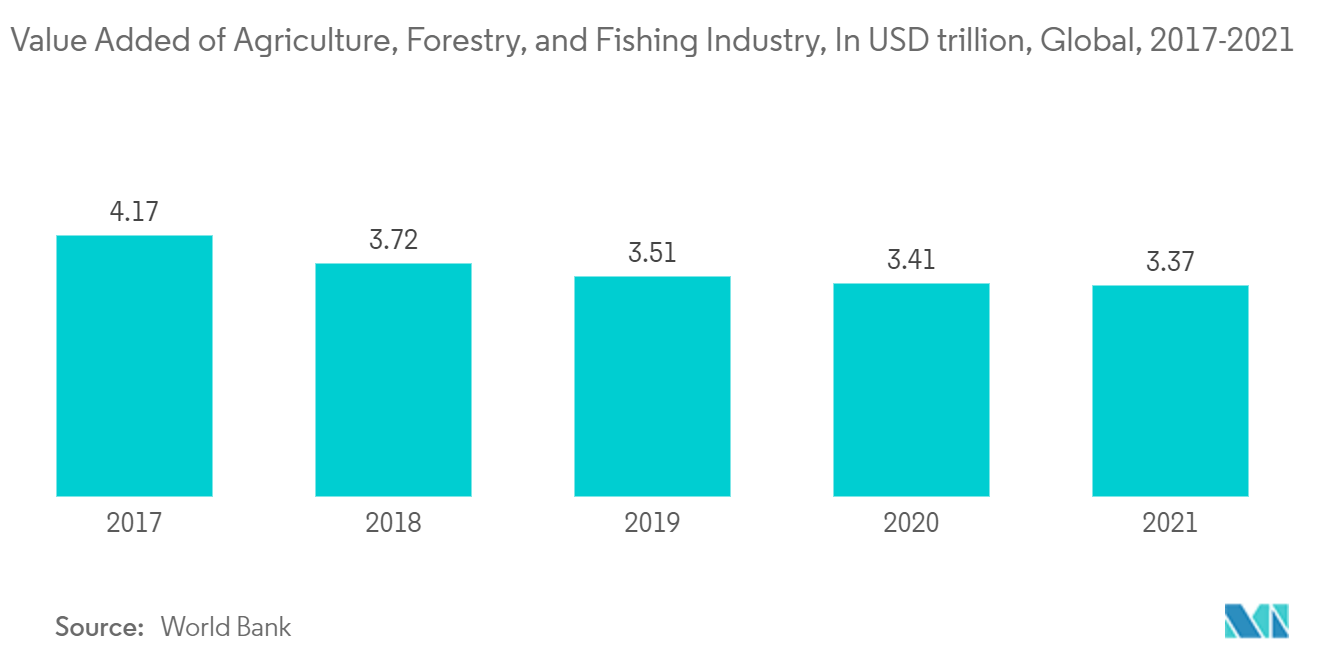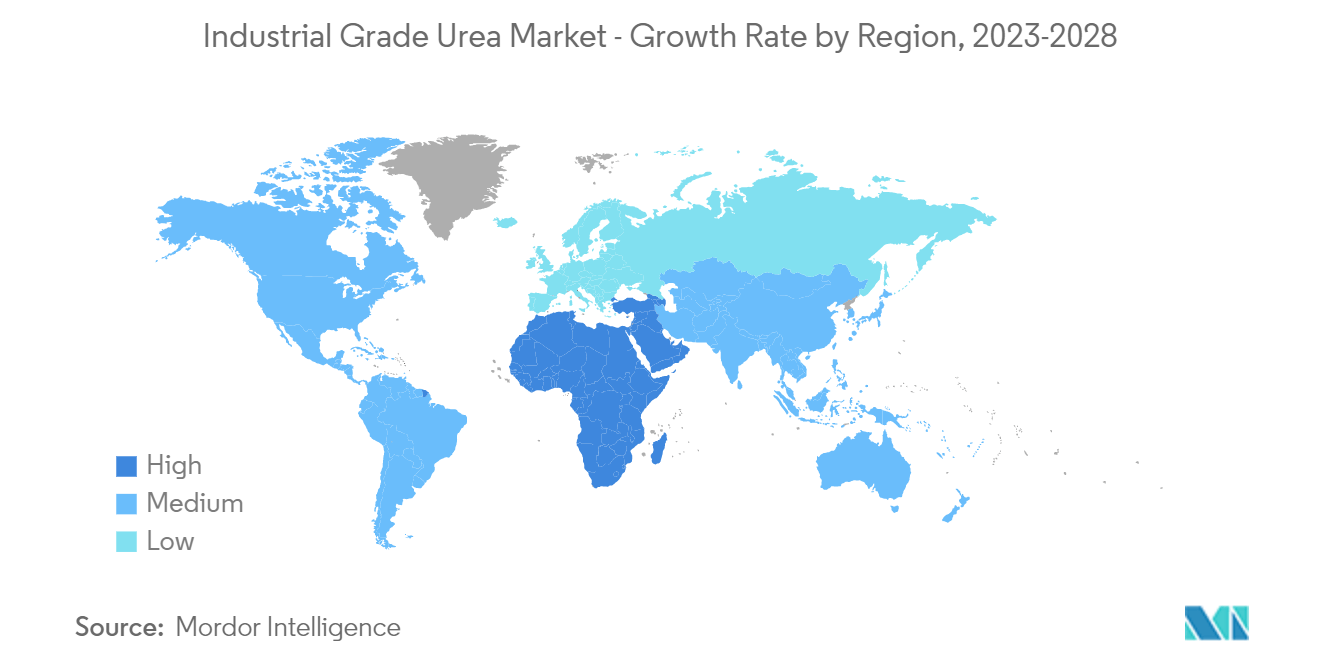Market Trends of Industrial Grade Urea Industry
Agriculture Segment to Dominate the Market
- Urea (NH2)2CO is a colorless organic chemical compound known as carbamide. It is highly soluble in water and has a pKa close to zero. More than 90% of the world's urea production is used as a nitrogen-release fertilizer. Urea has the highest nitrogen content of all solid nitrogenous fertilizers in common use (46.7%). Therefore, it has the lowest transportation costs per unit of nitrogen nutrients.
- In the soil, it hydrolyses back to ammonia and carbon dioxide. Bacteria oxidize the ammonia in the soil to nitrate, which the plants can absorb. Urea is also used in many multi-component solid fertilizer formulations. Urea is highly soluble in water, therefore, very suitable for use in fertilizer solutions (in combination with ammonium nitrate: UAN), e.g., in 'foliar feed' fertilizers. For fertilizer use, granules are preferred because of their narrower particle size distribution, an advantage for mechanical application.
- Nitrogen fertilizers are viable methods for expanding crop yield and profitability, particularly in the non-chernozem zone and moist areas. Nitrogen fertilizers are specially used as supplements for crops and are primarily utilized in the agriculture industry for harvesting.
- According to the World Bank, the total value of the agriculture, forestry, and fishing industries accounted for USD 4.17 trillion in 2021, compared to USD 3.72 trillion in the previous year.
- The Asia-Pacific region holds heavy reliance on nitrogenous fertilizers at present. However, the use of nitrogenous fertilizers, poor nutrition management, declining soil fertility, lack of complementary inputs, and weak marketing and distribution systems are some of the concerns in the Asia-Pacific agriculture sector. Regardless, the demand for nitrogenous fertilizer is still likely to dominate the fertilizer market in the region over the next few years, which is likely to continue driving the consumption of the urea market.
- Furthermore, agriculture is the primary source of livelihood across the globe. Countries such as India and the United States, among others, are witnessing positive growth in the agriculture sector. Hence, the demand for ammonia is expected to drive the market during the forecast period.
- For FY22, the Indian government has set a record target for farmers to raise food grain production by 2%, with 307.31 million tons of food grains. In FY21, production was recorded at 303.34 million tons against a target of 301 million tons. Thus, these factors are expected to increase the demand for fertilizers, driving the market studied.
- In addition, the American agricultural industry witnessed the highest annual export levels ever recorded in 2021. The 2021 trade data published by the Department of Commerce shows that exports of US farm and food products to the world totaled USD 177 billion, topping the 2020 total by 18%, driven by higher prices and larger quantities as global demand strengthens.
- The agriculture sector in Latin America and the Caribbean witnessed significant growth in the recent past. According to the Organization for Economic Co-operation and Development (OECD) and the Food and Agriculture Organization of the United Nations (FAO), agricultural and fisheries production is expected to grow by 17% during the forecast period. Around 53% of this growth is expected to come from an increase in crop production.

Asia-Pacific Region to Dominate the Market
- The Asia-Pacific region accounts for the highest market share, followed by North America.
- With the increase in population, developments in the agriculture industries are taking place in countries like India and China. This increases the consumption of nitrogen fertilizers, thereby driving the market.
- Apart from the agriculture industry, consumption is also increasing with the advancements in the chemical, automobile, and medical industries.
- Chinese authorities are imposing new hurdles for fertilizer exporters among growing concerns over surging power prices and food production, which could worsen a global price shock and food inflation.
- China is one of the largest producers of urea-formaldehyde resin in the world. The urea-formaldehyde resins are used in construction as adhesives for bonding plywood, particleboard, and other wood products.
- According to the National Bureau of Statistics, in 2021, grain production totaled 682.9 million tons, up from 650 million tons last year, registering an increase of 2%. Corn acreage rose 5 percent from last year, and output rose 4.6 percent. The growing use of fertilizers to increase productivity to keep up with the declining cultivated area is expected to drive the market in the country.
- China exported 849,000 tons of urea from July 2022 to September 2022, up from 303,000 tons and 421,000 tons during Q1 2022 and Q2 2022, respectively.
- According to the OICA, China has the world's most significant automotive production base, with a total vehicle production of 26.08 million units in 2021, registering an increase of 3% compared to 25.23 million units produced last year.
- In 2021, retail sales of fertilizers in India had fallen 12.4% in April-July over the four months of last year. All major nutrients have posted lower sales, and urea observed the highest decline of 12.8%.
- According to the Fertilizer Association of India, the production of total fertilizer products stood at 43.49 million MT during 2020-21, showing an increase of 1.7% over 2019-20. The production of urea stood at 24.60 million MT, NP/ NPK complex fertilizers at 9.32 million MT, and SSP at 4.92 million MT during 2020-21, recording an increase of 0.6%, 7.6%, and 15.8%, respectively, over 2019-20. However, production of DAP at 3.77 million MT witnessed a sharp decline of 17.1% during the same period.
- Furthermore, India is among the largest producer of automobiles in the world. According to OICA, the automotive production in the country stood at 4.4 million units in 2021, registering an increase of 30% compared to 3.38 million units produced in the same period last year.


